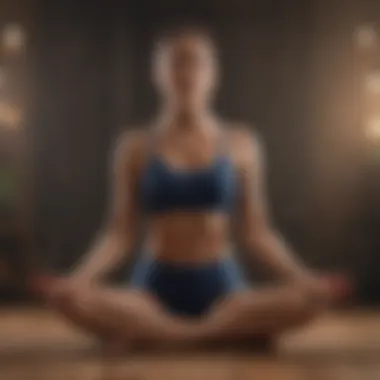What You Do When You Meditate: A Guide


Intro
Meditation has become increasingly popular as a means of enhancing mental health, fostering relaxation, and achieving mindfulness. This practice is often considered an essential routine for those seeking peace in a fast-paced world. Many individuals wonder what actually takes place during meditation sessions. What techniques are employed? How does the act of meditating benefit the body and mind? Understanding these aspects can lead to a more profound meditation experience, encouraging both beginners and seasoned practitioners to deepen their practices.
Understanding the Essence of Meditation
Meditation serves as a multifaceted practice that transcends mere relaxation. It offers a means to connect deeply with one’s inner self, fostering increased awareness and emotional clarity. In this article, we will delve into the core elements of meditation, emphasizing its relevance and importance for both novice and experienced practitioners alike.
Definition and Purpose of Meditation
Meditation is often defined as a technique that encourages an enhanced state of awareness and focused attention. Its primary purpose varies among individuals, but generally, it aims to cultivate a greater understanding of one's thoughts and emotions. Many people engage in meditation to reduce stress, improve focus, or simply to seek peace of mind. The practice allows individuals to step back from the chaos of daily life, becoming observers of their own mental processes.
The processes of meditation can differ greatly depending on the school of thought or technique used. Some may focus solely on breath, while others engage in visualization or mantra repetition. Regardless of the specific method, the outcome is often a clearer mind and better emotional regulation.
Benefits of Regular Meditation Practice
Consistent meditation practice yields numerous benefits that impact mental, physical, and emotional well-being. Here are a few key advantages:
- Improved Mental Clarity: Regular meditation helps clear the mind of distractions. Over time, this leads to sharper focus and better decision-making.
- Emotional Resilience: Those who meditate frequently develop stronger emotional control. This aids in managing stress and anxiety effectively.
- Enhanced Self-Awareness: As one meditates, they gain insights into their habitual thought patterns. This self-awareness can lead to meaningful life changes.
- Better Physical Health: Studies suggest that meditation can lower blood pressure and improve sleep quality, contributing to overall health.
Regular meditation encourages not only internal tranquility but also fosters a better understanding of external relations.
Preparing for Meditation
Preparing for meditation is a crucial step that dictates the quality of the practice. A well-prepared approach enhances focus, deepens the experience, and promotes a more profound connection between the mind and body. It is essential to address several specific aspects that form the foundation of a successful meditation session. This includes crafting an appropriate environment, selecting the optimal time, and ensuring proper physical readiness and posture.
Creating a Suitable Environment
The environment where you meditate can significantly influence your experience. It is beneficial to find a space that is quiet, free from distractions, and conducive to relaxation. A clean and comfortable area promotes a sense of safety and serenity.
- Lighting: Soft, natural light is ideal. If possible, avoid harsh fluorescent lighting that may cause discomfort.
- Temperature: Ensure that the room temperature is comfortable; being too hot or too cold can shift your focus away from meditation.
- Aroma: Consider using soothing scents such as lavender or sandalwood. They can enhance relaxation and create a tranquil atmosphere.
- Personal Touch: Including cushions, blankets, or items that bring you peace can make the space feel more inviting.
In summary, these elements work together to create a harmonious setting that encourages focus and promotes deep meditation.
Choosing the Right Time
Timing is a considerable factor in meditation practice. The best times to meditate generally align with periods of reduced distraction and heightened calmness. Morning sessions can serve as an excellent start to the day, while evenings offer a chance to unwind and reflect. Knowing your personal rhythm can help determine the best time for you.
- Consistency: Try to meditate at the same time daily. This regularity helps to reinforce the habit.
- Listening to Your Body: Some people may find meditating after physical exercise beneficial, as it may enhance mental clarity.
- Avoiding Rushed Times: Ensure you have the adequate time to devote to your practice, preventing interruptions.
Ultimately, finding your ideal meditation time can nurture a deeper connection to the practice and allow the experience to flourish.
Physical Preparation and Posture
Physical readiness is vital in ensuring a successful meditation session. Practitioners need to find a posture that supports both comfort and alertness. Being aware of your body before you start can help in achieving this balance.
- Posture: You may choose to meditate sitting cross-legged, in a chair, or even lying down. The key is to maintain a straight back and relaxed shoulders. Posture influences your ability to breathe deeply and affects overall concentration.
- Stretching: Engaging in a few stretches prior to meditation can help alleviate tension in the body, making it easier to settle into your practice.
- Breath Awareness: Before starting, take a few moments to focus on your breath. This simple act can ground you in the present, preparing your mind for meditation.


By paying attention to how you physically prepare, you lay the groundwork for a fruitful meditation experience.
"The quieter you become, the more you can hear."
In essence, preparing for meditation is about cultivating an environment, timing, and physical readiness that supports a meaningful experience. Incorporating these elements ensures a more profound engagement with the practice and enhances the potential benefits of meditation.
Key Techniques in Meditation
Meditation encompasses various techniques, each offering unique benefits and experiences. These techniques serve as pathways to deepen one’s meditation practice, enabling both beginners and seasoned practitioners to explore the mental landscape. Understanding these methods can bolster one’s commitment, making meditation a more enriching and effective practice. Each technique has its nuances, and knowing what they entail enhances the ability to engage fully in the practice.
Mindfulness Meditation
Mindfulness meditation emphasizes being present in the moment. It encourages practitioners to observe their thoughts, feelings, and surroundings without judgment. This heightened awareness fosters a sense of clarity and calm. During mindfulness meditation, one may focus on sensations like the breath or external noises.
The benefit of mindfulness meditation is notable in reducing anxiety and improving emotional regulation. Regular practice helps to cultivate resilience to stress and promotes mental clarity. To start, find a quiet space, sit comfortably, and begin to notice your breath. If distractions arise, gently guide your attention back to your breath.
Breath Awareness
Breath awareness is a fundamental technique in many meditation types. Focusing on the inhales and exhales helps anchor the mind. This simple yet profound practice allows for a connection to the body. By concentrating on breath, you create a rhythm that calms the nervous system.
Body Scan Technique
The body scan technique involves mentally scanning different areas of the body, from head to toe. It encourages relaxation and fosters a connection between mind and body. During this practice, practitioners may notice tension areas, sensations, or emotions trapped within the body.
This technique is particularly useful for understanding physical discomfort. It promotes relaxation by increasing body awareness. To begin, lie down comfortably and focus on each body part in sequence. Notice how they feel, allowing tension to release with each exhalation. This method not only calms but also provides insights into your physical state, thus enhancing self-awareness in daily life.
Guided Visualization
Guided visualization involves using imagery to facilitate relaxation and positive thinking. It guides practitioners through various scenarios, helping them visualize a peaceful scene or a specific goal. This method combines imagination with mindfulness, producing profound effects on mental clarity and emotional well-being.
Engaging in guided visualization can enhance creativity and reduce stress, making it popular among those seeking deeper mental exploration. Many resources and recordings are available for support. To use this technique, close your eyes, breathe deeply, and follow a guided script or recording. This practice engages the mind actively, shifting it towards positive imagery and emotional states.
Loving-Kindness Meditation
Loving-kindness meditation focuses on fostering compassion and love towards oneself and others. Practitioners often begin by developing feelings of love internally before extending these feelings outward. This technique helps promote empathy, reduces feelings of isolation, and improves overall emotional health.
To practice loving-kindness meditation, sit comfortably, take deep breaths, and silently repeat phrases that express good wishes towards yourself and others. This practice not only nurtures positive emotions but also transforms relationships with oneself and others. Regular engagement can significantly increase a sense of connection and happiness.
"Meditation is not about becoming a different person, but about becoming who you really are."
These five core techniques provide a framework for engaging in meditation. Each method carries its own benefits and relevance, shaping the way one interacts with thoughts, emotions, and the self. Incorporating these techniques into a meditation practice can foster a profound transformation, enriching both the mind and heart.
Engaging in Meditation Practice
Engaging in meditation practice is a pivotal aspect of the meditation experience. It is through active participation that one reaps the rewards of this ancient technique. Practitioners often encounter numerous opportunities to deepen their awareness and enhance their mental well-being during this process. The act of engaging goes beyond mere sitting in silence. It is about actively connecting with one’s thoughts, feelings, and sensations.
Setting Intentions


Setting intentions is a foundational step to enhance the quality of meditation practice. It involves establishing a clear purpose before commencing meditation. Whether it is seeking calmness, clarity, or emotional healing, intentions serve as guideposts, directing attention during meditation. This process helps in cultivating focus, ultimately influencing the depth of the experience. Having a clear intention can remind practitioners of their goals and keep their minds anchored amidst worldly distractions. It can be as simple as saying to yourself, "I want to cultivate gratitude" or "I aim to find peace in this moment."
The Role of Concentration
Concentration plays a crucial role in meditation. It is the skill that allows individuals to maintain their focus on a particular point, whether it is breath, sound, or thought. Enhanced concentration can lead to a more profound meditative experience. As one improves their ability to concentrate, their awareness expands, ushering in a greater understanding of the self. Start with brief sessions focused solely on the breath. Over time, gradually increasing the duration can help strengthen concentration and make meditation more fulfilling.
Recognizing Distractions
Distractions are an inherent part of the human experience, especially during meditation. Recognizing these distractions can be transformative. Instead of viewing distractions as obstacles, it's beneficial to acknowledge them as they arise, understanding they are natural. This awareness allows practitioners to create a distance between themselves and these thoughts. The goal is not to eliminate distractions, but rather to recognize them without judgment. Simple techniques like noting when a thought appears can assist in this process, helping individuals to release it gently, returning their focus to their intention or breathing.
Returning to Focus
The ability to return to focus after a distraction is critical. Each time a practitioner finds their mind wandering, it's an opportunity to strengthen their practice. The act of returning to the chosen point of focus can be seen as a small victory. Techniques such as taking a deep breath or visualizing a calming image can help re-establish focus. This cyclical nature of losing and regaining focus reflects the core of meditation—the journey towards mindfulness and awareness. Emphasizing this practice during meditation can provide a pragmatic approach to dealing with distractions in daily life.
By actively engaging in these aspects of meditation practice, individuals lay the groundwork for a more enriching and transformative experience. Consistent practice will not only deepen one’s meditation but also foster mental clarity, emotional balance, and overall well-being.
Engaging deeply in each aspect of meditation enhances both the experience and the benefits derived from it. Practitioners willing to immerse themselves in intention, concentration, and awareness of distractions will find their meditation journey to be profoundly rewarding.
Post-Meditation Reflection
Post-meditation reflection serves as a critical step in the overall meditation practice. This phase allows practitioners to distill their experiences during meditation, leading to a deeper understanding of their thoughts and feelings. It encourages the integration of insights gained during meditation into everyday life. Often, people overlook this aspect, neglecting the potential insights that can arise after the practice itself. By taking time to reflect, practitioners can enhance their mental clarity and emotional balance.
Noting Changes in Awareness and Perception
After meditation, an individual may notice subtle changes in their awareness and perception. The clarity one experiences can be profound. Thoughts may become more organized and manageable, emotions may feel less intense, and reactions to external stimuli can shift. Practitioners often report heightened emotional awareness. They begin to recognize patterns and triggers that may have previously gone unnoticed.
- Increased Mindfulness: A consistent practice helps in cultivating mindfulness, encouraging practitioners to be more in tune with their mental state.
- Shifted Perspectives: Meditation can lead to a change in how one views problems and challenges, allowing for a more open-minded approach to life's issues.
Reflecting on these changes can amplify the benefits of meditation. By jotting down insights or thoughts that arise after the session, individuals can track their progress and growth over time. This journaling can serve as a valuable tool for personal development.
Integrating Insights into Daily Life
Integrating insights gained from meditation into daily life is essential for reaping the full benefits of the practice. Understanding how to apply newfound awareness can enhance one's quality of life. For instance, if a practitioner identifies certain stress triggers during meditation, they can actively work to avoid or manage these triggers in their daily routine.
- Mindful Responses: By adopting mindful responses to daily challenges, one can cultivate a more peaceful mindset.
- Routine Changes: Simple adjustments in daily routines may lead to significantly improved emotional and mental well-being.
It is useful to consider practical strategies for this integration:
- Daily Reflection: Spend a few minutes each day to reflect on meditation insights.
- Mindfulness Reminders: Set reminders throughout the day to pause and reflect.
- Community Engagement: Join a meditation group or community to share insights and encourage accountability.
"Meditation is not just about finding peace; it’s about taking that peace and applying it in the world around us."
Challenges Faced During Meditation
Meditation, while offering numerous benefits, does not come without its challenges. Understanding these obstacles is crucial for anyone looking to embrace a regular meditation practice. Addressing the various difficulties can enhance one's experience, deepening their engagement in the process and allowing for more significant outcomes. This section examines three primary areas of concern: mental and emotional barriers, physical discomfort, and consistency and commitment issues. Recognizing and navigating these aspects can empower individuals to better integrate meditation into their lives.
Mental and Emotional Barriers


Mental and emotional barriers represent common hurdles experienced during meditation. Many practitioners find that their minds are cluttered with thoughts, worries, and distractions. This internal noise can lead to frustration, making it difficult to achieve a state of calm. One may experience feelings of impatience or self-criticism for failing to quiet the mind, which can deter continued practice. To overcome these barriers, it is essential to develop a sense of acceptance toward one's thoughts. Acknowledging the presence of distractions, rather than resisting them, can facilitate a more serene environment.
Some effective strategies to combat mental hurdles include:
- Setting realistic expectations: Understand that experiencing a quiet mind is not a requirement for meditation success.
- Practicing self-compassion: This involves being gentle with oneself and recognizing the journey of meditation as an evolving process.
- Utilizing guided meditations: These can help anchor attention and provide structure, easing the sensation of wandering thoughts.
Physical Discomfort
Physical discomfort can disrupt the meditation experience. Practitioners may encounter sensations of tightness, pain, or restlessness in their bodies. Such feelings can arise from long durations of sitting or improper postures. It is vital to acknowledge these discomforts without allowing them to dictate the meditation experience. Developing an awareness of bodily sensations can aid in understanding when to adjust posture or take breaks.
To manage physical discomfort during meditation, consider:
- Finding a comfortable position: Whether sitting in a chair, on a cushion, or lying down, ensure the body feels at ease.
- Incorporating movement: Engaging in gentle stretching before meditation can help release tension.
- Practicing shorter sessions: Start with brief periods of meditation and gradually increase the duration as comfort improves.
Consistency and Commitment Issues
Maintaining a consistent meditation practice can prove challenging for many individuals. Daily interruptions, busy schedules, or lack of motivation can lead to irregular meditation habits. This inconsistency can diminish the potential benefits of meditation. Establishing a routine is crucial in ensuring that meditation becomes a lasting part of daily life.
To foster commitment, consider the following:
- Designate a specific time for meditation: Choose a time that fits well within the daily schedule and stick to it.
- Create a dedicated meditation space: Having a specific area for practice can enhance the intention and focus of each session.
- Tracking progress: Keeping a journal or using a meditation app can offer insights into the days practiced, which can encourage perseverance.
"Meditation is not a means to an end. It is both the means and the end." – Jiddu Krishnamurti
Embracing the challenges of meditation is part of its practice. By recognizing mental and emotional barriers, alleviating physical discomfort, and committing to a consistent routine, one can navigate obstacles effectively. This proactive approach will ultimately lead to a more fulfilling meditation experience.
The End and Future Directions
Meditation is not just a practice; it is a profound journey that can transform one’s life. As we reach the end of this comprehensive guide, it is essential to reflect on the key insights and consider the path forward in our meditation practices.
The ongoing journey of meditation emphasizes that this practice is a continuous one. It is not about achieving a specific state or outcome but rather about engaging with the process, and exploring one’s thoughts and emotions deeply. Over time, practitioners may notice enhancements in mental clarity, emotional stability, and even physical health. Each meditation session adds another layer to the understanding of oneself, making it a personal and evolving experience.
"Meditation is not about stopping thoughts, but recognizing that we are more than our thoughts and our feelings."
Moreover, the commitment to regular practice can significantly impact one's life. It can lead to improved mindfulness in daily activities, enhancing the quality of interactions and decision-making. With continued reflection, individuals can integrate insights gained from meditation into their everyday lives, cultivating a deeper connection with both themselves and the external world.
The Ongoing Journey of Meditation
The path of meditation is very much like a river. It flows, with twists and turns, and each bend reveals something new. Engaging in meditation means embracing personal growth. It encourages self-discovery and an increased understanding of the mind and body. Regular meditators often find that their perceptions shift over time. What initially seemed challenging becomes more manageable. Practitioners learn to navigate their internal landscapes with greater ease.
Every session is a new opportunity to learn.
- Mindful Awareness: One begins to notice thoughts without judgment, creating gaps between impulse and action.
- Emotional Regulation: Individuals often experience a greater ability to handle difficult emotions calmly.
- Heightened Focus: The practice sharpens concentration, which translates into increased productivity in various aspects of life.
To ensure growth, it is crucial to remain open to the process. Recognizing that meditation may evolve through different phases keeps the practice alive and engaging.
Encouraging Continued Practice
The most significant part of any meditation journey is consistency. Encouraging continued practice involves a few considerations. It is essential to create a routine; finding a specific time each day for meditation can instill discipline. Morning sessions may enhance focus for the day ahead, while evening meditations can aid in reflection and relaxation.
Another essential factor is setting intentions for each session. This can guide what practitioners hope to achieve or explore, whether it be enhancing calmness, clarity, or emotional healing.
Consider joining a community or group that practices meditation. These settings provide support and motivation, making it easier to stay committed. Online resources, such as forums or social media groups, can also foster connection and shared experiences.
- Practice Patience: Progress may feel slow. Recognize that small changes add up.
- Explore Different Techniques: Variety can keep practice fresh. Try different methods like Loving-Kindness or Body Scan meditation.
- Reflect on your Practice: Keeping a journal of reflections can highlight personal growth and challenges.







